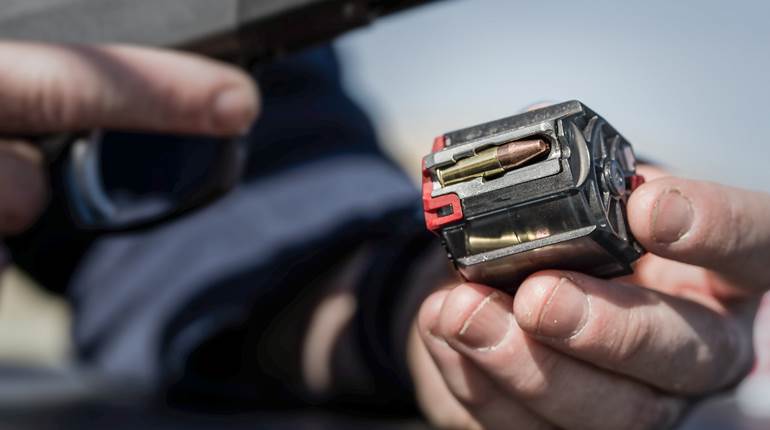
The ashes of World War II were still warm when tensions between the Soviet Union and western Europe, as well as the United States, brought forth the North Atlantic Treaty Organization (NATO). Not long after its commencement on April 4, 1949, a treaty was established, and the alliance began searching for a replacement cartridge for the .30-’06 Sprg. After trials, revisions and more trials, the T65E3, T65E4 and T65E5 were chosen, now officially called the 7.62x51 mm NATO cartridge. Winchester jumped at it commercially in 1952 when it introduced the .308 Win. to the civilian market in a new Featherweight version of its popular Model 70 bolt-action rifle.

Shown above are factory cartridges based on the .308 Winchester cartridge case: (l. to r.) .243 Win., .260 Rem., 7 mm-08 Rem., .308 Win., and 358 Win.
Wildcatters were already experimenting with necking down the case to accept 6 mm (0.243") bullets. Field & Stream Shooting Editor Warren Page came up with a cartridge he called the .240 Page Super Pouper, using it on red stags in New Zealand and woodchucks in the American northeast. Fred Huntington of RCBS fame came up with a similar cartridge, the .243 Rockchucker. The idea was to have one dual-use cartridge that could drive 80-grain varmint bullets in the 3,200 f.p.s. range and 100- to 105-grain deer or antelope bullets at 3,000 f.p.s. In 1955, Winchester settled on the final dimensions, and the .243 Win. was born. It should be noted that Remington was in the game as well, introducing the .244 Remington cartridge, which would be later renamed the 6 mm Remington.
However, it was the .243 Win. that caught the shooting public’s eye. Here was a cartridge in a lightweight, high-quality hunting rifle that could provide true dual-purpose varmint and deer hunting. Recoil was a pleasant 10 ft.-lbs. compared to a .30-’06 Sprg. at 17 ft.-lbs. in a sporter-weight rifle. Both rifle and cartridge were an immediate success and remain so today. The .243 Win. has become a must-have in the household arsenal where families raise their children to be hunters because its effectiveness on deer and other medium-size game, while also limiting recoil that standard chamberings, such as .308 Win., produces.
Winchester may have introduced the .243 Win. in its Model 70 bolt-action and Model 88 lever action, but another company, Savage, chambered its iconic Model 99 in it soon after; even Remington chambered its Model 722 for the cartridge, despite having its own new .244-cal. round. Later, in 1961, Winchester made its semi-automatic Model 100 chambered for .243 Win. Numerous other rifles, from single shots to semi-autos on the AR platform, come in .243 Win., too. The .243 Win. jumped across the pond early on, with several European gunmakers chambering their rifles for it. It remains a popular cartridge for roe and fallow deer.

Factory loads for the .243 Winchester cartridge range from 55 to 115 grains. Shown here (l. to r.): SIG Sauer, Varmint & Predator Tip, 55 grain; Browning BXV Varmint Expansion, 65 grain; Hornady Superformance Varmint, V-MAX, 75 grain; Federal Premium, Sierra Gameking, 85 grain; Remington Premier, Scirocco Bonded, 90 grain and Hornady American Whitetail, Interlock, 100 grain.
P.O. Ackley, after repeated requests from customers, did one of his improvements to the .243 Winchester by blowing out most of the body taper and increasing the shoulder angle to 40 degrees, creating The .243 Winchester AI (Ackley Improved). Either loved or hated, some feel the increased powder and velocity are key, making it a truly long-range target cartridge, while others maintain that it is an overpowered barrel-eater. Ackley felt that the only real advantage of his version was the reduction in case stretch, thanks to the sharp shoulder, thereby lengthening case life.
Shooters had relatively few bullets to choose from when the .243 Win. cartridge was introduced; largely limited to cup-and-core 80- and 100-grainers. Today, factory loads run from 55-grain Ballistic Silvertips from Winchester at 3,910 f.p.s. to 100-grain bonded bullets running at 2,960 f.p.s. If that isn’t stout enough for you, Hornady offers 110-grain A-Tip bullets for handloaders, and Berger has some 115-grainers for hunting or target use. Handloading for the .243 Win. is pretty straightforward. The cartridge is suited for a wide variety of powders, ranging from IMR 4064 to Norma MRP and Ramshot Magnum, depending upon the bullet weight.

While hunting may have been the primary purpose of the cartridge at its introduction, the .243 has been used in tactical roles, as well as target-shooting venues. The Los Angeles Police Department deployed .243-chambered bolt-action rifles to some of its early SWAT teams for urban-sniper situations. Today, it is popular with long-range practical-rifle competitors.
When I lived in California, several wild-pig guides swore by their .243 Win. rifles for finishing off pigs wounded by clients. Some hunters swore at it, because the relatively soft cup-and-core bullets offered at its introduction did not penetrate the gristle-like shield protecting the ribs on a boar. Once better bullets were made, like the Barnes TSX and TTSX, the nasty old boars started tipping over nicely with well-placed shots.

The .243 Win. has been a great cartridge on varmints and deer-size game for some 67 years and remains popular today. Yes, there are newer cartridges like the 6 mm and 6.5 mm Creedmoor that create some excitement for those who must find something newfangled and novel. But for a whole lot of shooters who don’t have their manhood tied to the cartridges they shoot, the .243 is just fine.






































